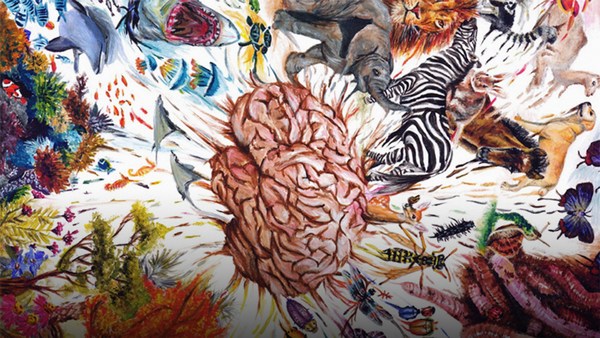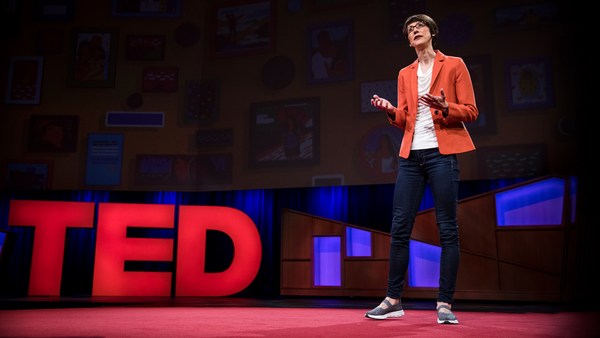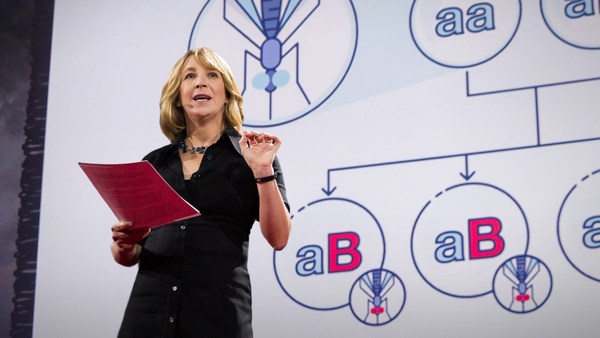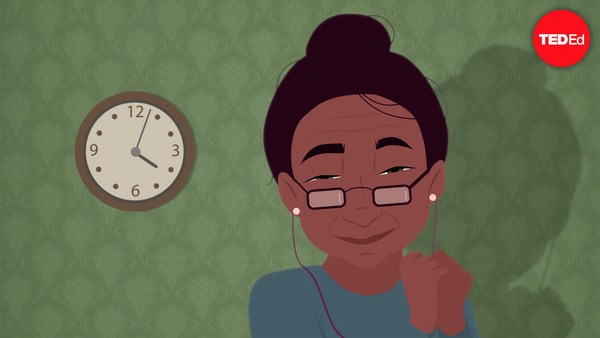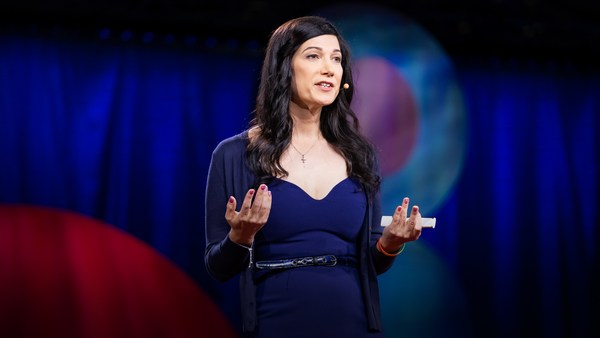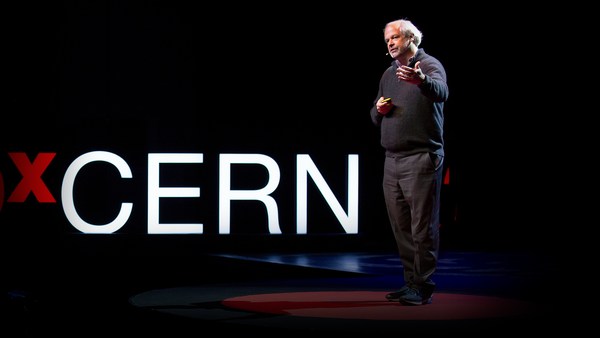Where does the end begin? Well, for me, it all began with this little fellow. This adorable organism -- well, I think it's adorable -- is called Tetrahymena and it's a single-celled creature. It's also been known as pond scum. So that's right, my career started with pond scum.
Now, it was no surprise I became a scientist. Growing up far away from here, as a little girl I was deadly curious about everything alive. I used to pick up lethally poisonous stinging jellyfish and sing to them. And so starting my career, I was deadly curious about fundamental mysteries of the most basic building blocks of life, and I was fortunate to live in a society where that curiosity was valued.
Now, for me, this little pond scum critter Tetrahymena was a great way to study the fundamental mystery I was most curious about: those bundles of DNA in our cells called chromosomes. And it was because I was curious about the very ends of chromosomes, known as telomeres. Now, when I started my quest, all we knew was that they helped protect the ends of chromosomes. It was important when cells divide. It was really important, but I wanted to find out what telomeres consisted of, and for that, I needed a lot of them. And it so happens that cute little Tetrahymena has a lot of short linear chromosomes, around 20,000, so lots of telomeres. And I discovered that telomeres consisted of special segments of noncoding DNA right at the very ends of chromosomes.
But here's a problem. Now, we all start life as a single cell. It multiples to two. Two becomes four. Four becomes eight, and on and on to form the 200 million billion cells that make up our adult body. And some of those cells have to divide thousands of times. In fact, even as I stand here before you, all throughout my body, cells are furiously replenishing to, well, keep me standing here before you. So every time a cell divides, all of its DNA has to be copied, all of the coding DNA inside of those chromosomes, because that carries the vital operating instructions that keep our cells in good working order, so my heart cells can keep a steady beat, which I assure you they're not doing right now, and my immune cells can fight off bacteria and viruses, and our brain cells can save the memory of our first kiss and keep on learning throughout life.
But there is a glitch in the way DNA is copied. It is just one of those facts of life. Every time the cell divides and the DNA is copied, some of that DNA from the ends gets worn down and shortened, some of that telomere DNA. And think about it like the protective caps at the ends of your shoelace. And those keep the shoelace, or the chromosome, from fraying, and when that tip gets too short, it falls off, and that worn down telomere sends a signal to the cells. "The DNA is no longer being protected." It sends a signal. Time to die. So, end of story.
Well, sorry, not so fast. It can't be the end of the story, because life hasn't died off the face of the earth. So I was curious: if such wear and tear is inevitable, how on earth does Mother Nature make sure we can keep our chromosomes intact?
Now, remember that little pond scum critter Tetrahymena? The craziest thing was, Tetrahymena cells never got old and died. Their telomeres weren't shortening as time marched on. Sometimes they even got longer. Something else was at work, and believe me, that something was not in any textbook. So working in my lab with my extraordinary student Carol Greider -- and Carol and I shared the Nobel Prize for this work -- we began running experiments and we discovered cells do have something else. It was a previously undreamed-of enzyme that could replenish, make longer, telomeres, and we named it telomerase. And when we removed our pond scum's telomerase, their telomeres ran down and they died. So it was thanks to their plentiful telomerase that our pond scum critters never got old.
OK, now, that's an incredibly hopeful message for us humans to be receiving from pond scum, because it turns out that as we humans age, our telomeres do shorten, and remarkably, that shortening is aging us. Generally speaking, the longer your telomeres, the better off you are. It's the overshortening of telomeres that leads us to feel and see signs of aging. My skin cells start to die and I start to see fine lines, wrinkles. Hair pigment cells die. You start to see gray. Immune system cells die. You increase your risks of getting sick. In fact, the cumulative research from the last 20 years has made clear that telomere attrition is contributing to our risks of getting cardiovascular diseases, Alzheimer's, some cancers and diabetes, the very conditions many of us die of.
And so we have to think about this. What is going on? This attrition, we look and we feel older, yeah. Our telomeres are losing the war of attrition faster. And those of us who feel youthful longer, it turns out our telomeres are staying longer for longer periods of time, extending our feelings of youthfulness and reducing the risks of all we most dread as the birthdays go by.
OK, seems like a no-brainer. Now, if my telomeres are connected to how quickly I'm going to feel and get old, if my telomeres can be renewed by my telomerase, then all I have to do to reverse the signs and symptoms of aging is figure out where to buy that Costco-sized bottle of grade A organic fair trade telomerase, right? Great! Problem solved.
(Applause)
Not so fast, I'm sorry. Alas, that's not the case. OK. And why? It's because human genetics has taught us that when it comes to our telomerase, we humans live on a knife edge. OK, simply put, yes, nudging up telomerase does decrease the risks of some diseases, but it also increases the risks of certain and rather nasty cancers. So even if you could buy that Costco-sized bottle of telomerase, and there are many websites marketing such dubious products, the problem is you could nudge up your risks of cancers. And we don't want that.
Now, don't worry, and because, while I think it's kind of funny that right now, you know, many of us may be thinking, "Well, I'd rather be like pond scum," ...
(Laughter)
there is something for us humans in the story of telomeres and their maintenance. But I want to get one thing clear. It isn't about enormously extending human lifespan or immortality. It's about health span. Now, health span is the number of years of your life when you're free of disease, you're healthy, you're productive, you're zestfully enjoying life. Disease span, the opposite of health span, is the time of your life spent feeling old and sick and dying. So the real question becomes, OK, if I can't guzzle telomerase, do I have control over my telomeres' length and hence my well-being, my health, without those downsides of cancer risks? OK?
So, it's the year 2000. Now, I've been minutely scrutinizing little teeny tiny telomeres very happily for many years, when into my lab walks a psychologist named Elissa Epel. Now, Elissa's expertise is in the effects of severe, chronic psychological stress on our mind's and our body's health. And there she was standing in my lab, which ironically overlooked the entrance to a mortuary, and --
(Laughter)
And she had a life-and-death question for me. "What happens to telomeres in people who are chronically stressed?" she asked me. You see, she'd been studying caregivers, and specifically mothers of children with a chronic condition, be it gut disorder, be it autism, you name it -- a group obviously under enormous and prolonged psychological stress. I have to say, her question changed me profoundly. See, all this time I had been thinking of telomeres as those miniscule molecular structures that they are, and the genes that control telomeres. And when Elissa asked me about studying caregivers, I suddenly saw telomeres in a whole new light. I saw beyond the genes and the chromosomes into the lives of the real people we were studying. And I'm a mom myself, and at that moment, I was struck by the image of these women dealing with a child with a condition very difficult to deal with, often without help. And such women, simply, often look worn down. So was it possible their telomeres were worn down as well?
So our collective curiosity went into overdrive. Elissa selected for our first study a group of such caregiving mothers, and we wanted to ask: What's the length of their telomeres compared with the number of years that they have been caregiving for their child with a chronic condition? So four years go by and the day comes when all the results are in, and Elissa looked down at our first scatterplot and literally gasped, because there was a pattern to the data, and it was the exact gradient that we most feared might exist. It was right there on the page. The longer, the more years that is, the mother had been in this caregiving situation, no matter her age, the shorter were her telomeres. And the more she perceived her situation as being more stressful, the lower was her telomerase and the shorter were her telomeres.
So we had discovered something unheard of: the more chronic stress you are under, the shorter your telomeres, meaning the more likely you were to fall victim to an early disease span and perhaps untimely death. Our findings meant that people's life events and the way we respond to these events can change how you maintain your telomeres. So telomere length wasn't just a matter of age counted in years. Elissa's question to me, back when she first came to my lab, indeed had been a life-and-death question.
Now, luckily, hidden in that data there was hope. We noticed that some mothers, despite having been carefully caring for their children for many years, had been able to maintain their telomeres. So studying these women closely revealed that they were resilient to stress. Somehow they were able to experience their circumstances not as a threat day in and day out but as a challenge, and this has led to a very important insight for all of us: we have control over the way we age all the way down into our cells.
OK, now our initial curiosity became infectious. Thousands of scientists from different fields added their expertise to telomere research, and the findings have poured in. It's up to over 10,000 scientific papers and counting. So several studies rapidly confirmed our initial finding that yes, chronic stress is bad for telomeres. And now many are revealing that we have more control over this particular aging process than any of us could ever have imagined. A few examples: a study from the University of California, Los Angeles of people who are caring for a relative with dementia, long-term, and looked at their caregiver's telomere maintenance capacity and found that it was improved by them practicing a form of meditation for as little as 12 minutes a day for two months. Attitude matters. If you're habitually a negative thinker, you typically see a stressful situation with a threat stress response, meaning if your boss wants to see you, you automatically think, "I'm about to be fired," and your blood vessels constrict, and your level of the stress hormone cortisol creeps up, and then it stays up, and over time, that persistently high level of the cortisol actually damps down your telomerase. Not good for your telomeres.
On the other hand, if you typically see something stressful as a challenge to be tackled, then blood flows to your heart and to your brain, and you experience a brief but energizing spike of cortisol. And thanks to that habitual "bring it on" attitude, your telomeres do just fine. So ... What is all of this telling us? Your telomeres do just fine. You really do have power to change what is happening to your own telomeres.
But our curiosity just got more and more intense, because we started to wonder, what about factors outside our own skin? Could they impact our telomere maintenance as well? You know, we humans are intensely social beings. Was it even possible that our telomeres were social as well? And the results have been startling. As early as childhood, emotional neglect, exposure to violence, bullying and racism all impact your telomeres, and the effects are long-term. Can you imagine the impact on children of living years in a war zone? People who can't trust their neighbors and who don't feel safe in their neighborhoods consistently have shorter telomeres. So your home address matters for telomeres as well. On the flip side, tight-knit communities, being in a marriage long-term, and lifelong friendships, even, all improve telomere maintenance.
So what is all this telling us? It's telling us that I have the power to impact my own telomeres, and I also have the power to impact yours. Telomere science has told us just how interconnected we all are.
But I'm still curious. I do wonder what legacy all of us will leave for the next generation? Will we invest in the next young woman or man peering through a microscope at the next little critter, the next bit of pond scum, curious about a question we don't even know today is a question? It could be a great question that could impact all the world. And maybe, maybe you're curious about you. Now that you know how to protect your telomeres, are you curious what are you going to do with all those decades of brimming good health? And now that you know you could impact the telomeres of others, are you curious how will you make a difference? And now that you know the power of curiosity to change the world, how will you make sure that the world invests in curiosity for the sake of the generations that will come after us?
Thank you.
(Applause)
